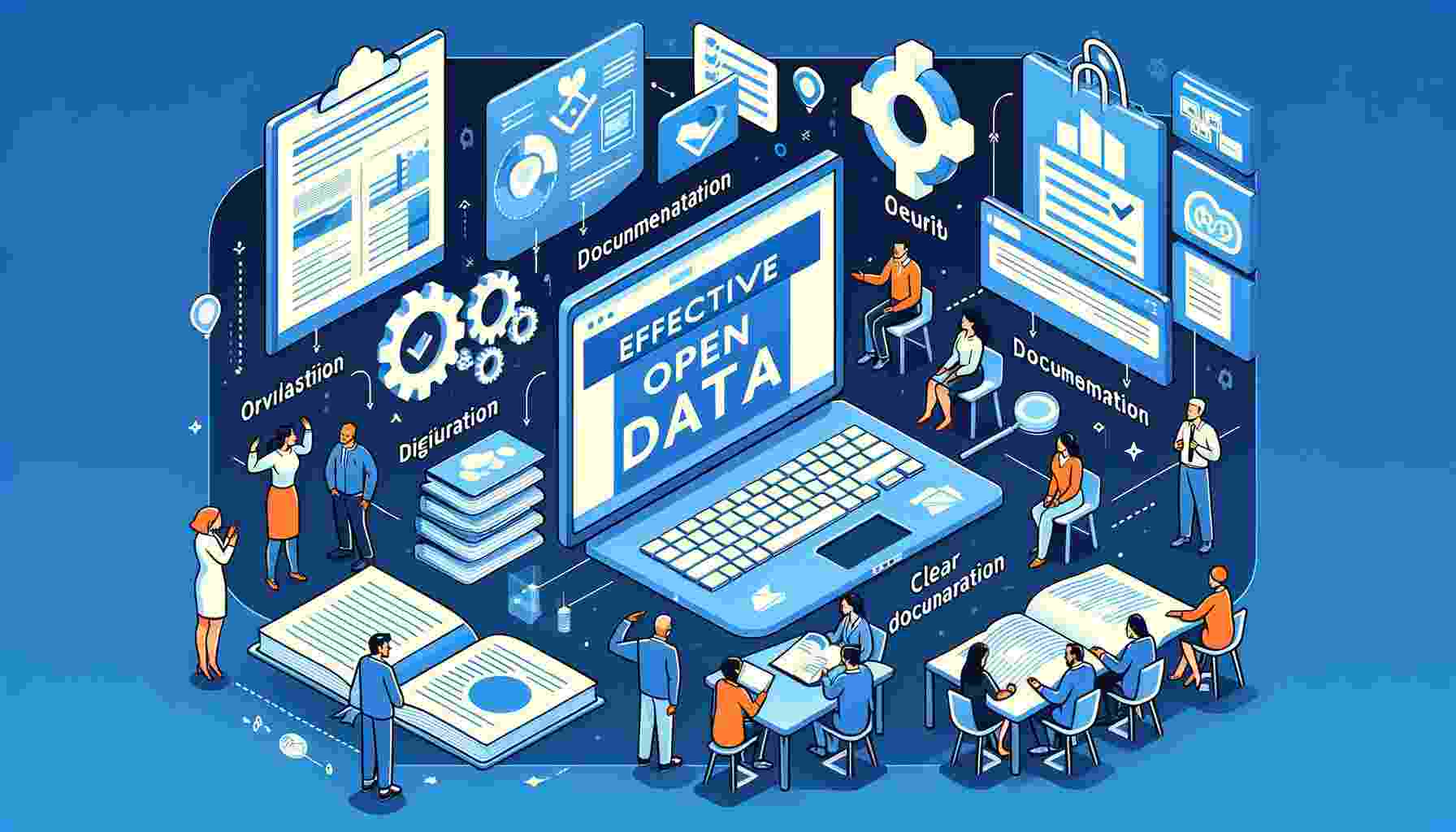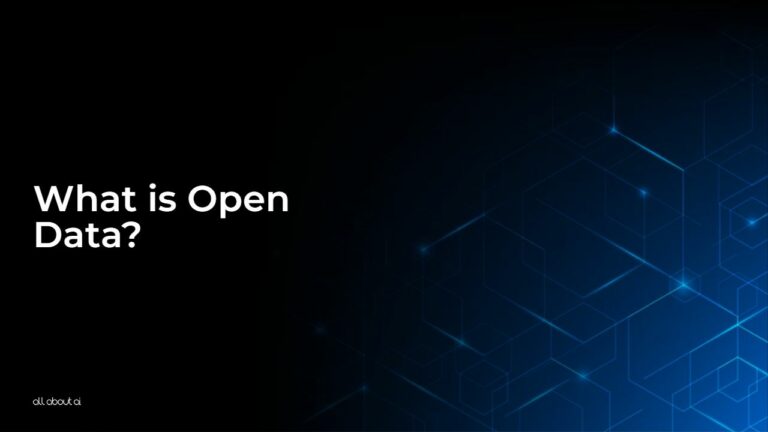What is open data? It refers to the concept of making data freely available to everyone, without any copyright or licensing restrictions. In the context of artificial intelligence (AI), open data is crucial as it fuels AI algorithms with diverse, real-world information, enhancing their learning and accuracy.
Looking to learn more about open data and its use in AI? Read this article written by the AI enthusiasts at All About AI.
What Types of Data Are Open?
Open data encompasses a wide array, including governmental statistics, research findings, environmental data, and much more. In AI, open datasets often include image libraries, speech repositories, and textual content that aid in machine learning model training.
- Governmental Data: Includes vital information like census data, public spending details, and legislative documents, crucial for maintaining transparency and aiding in public policy analysis and civic tech development.
- Geospatial Data: Comprises satellite imagery, GPS data, and topographic maps. Essential for environmental monitoring, urban planning, and disaster management, as well as applications like GPS navigation.
- Scientific Research Data: Encompasses data from experiments, surveys, and studies, pivotal for scientific progress, enabling replication of studies, fostering collaboration, and sparking new research ideas.
How Does Open Data Work in Different Sectors?

Various sectors benefit differently from open data. For instance, in healthcare, open data can lead to better disease prediction models, while in transportation, it can optimize route planning and traffic management.
Healthcare
In healthcare, open data revolutionizes patient care and research. Sharing aggregated health data helps in identifying disease trends, improving treatments, and informing public health policies.
Education
Open data in education leads to better resource allocation, understanding learning outcomes, and developing educational tools. Access to extensive educational data can drive innovation in teaching methodologies and learning technologies.
Business and Commerce
For businesses, open data is a resource for market analysis, competitor research, and consumer insights, identifying trends, optimizing operations, and creating new business models.
What Are the Steps to Prepare Data for Open Access?
Preparing data for open access involves ensuring data quality, anonymizing sensitive information, and formatting data in universally readable formats. This makes the data useful for a broad range of applications, especially in artificial intelligence.
- Data Cleaning: Involves removing errors, duplicates, and irrelevant entries to maintain the integrity of the dataset, ensuring the data is accurate, consistent, and usable.
- Anonymization: Critical for protecting personal and sensitive information, especially in datasets involving individual-level data, while maintaining privacy and legal compliance.
- Standardization: Ensuring data is formatted in universally understandable and accessible formats, using common data structures to ensure compatibility across different systems.
- Metadata Creation: Providing descriptive information about the dataset, like source and contents, essential for users to understand its context and applicability.
- Quality Assurance: Implementing checks to maintain data quality, including regular updates, error checking, and community feedback mechanisms.
How to Ensure Quality and Enrichment in Open Data?
Quality in open data is ensured through rigorous validation processes, consistent updating, and community feedback. Enrichment involves adding contextual information to make the data more valuable for AI applications.
Ensuring Data Quality
Maintaining the integrity and relevance of open data is crucial. Regular updates, validation processes, and adherence to standards ensure accuracy and usefulness. Community involvement in reporting errors also plays a vital role.
Enriching Data
Enriching open data involves adding contextual information, providing comprehensive documentation, and linking related datasets and databases, enhancing its potential applications.
Effective Strategies for Publishing and Sharing Open Data

Publishing open data effectively requires a user-friendly platform, clear documentation, and active community engagement to encourage widespread use and collaboration.
Creating Accessible Platforms
Platforms should be intuitive, with robust search functionalities and clear categorizations. Providing APIs also encourages integration with other tools.
Comprehensive Documentation
Detailed documentation and user guides assist users in effectively understanding and utilizing the data. Support channels like forums or helplines encourage wider use.
Encouraging Community Engagement
User feedback and community engagement refine data offerings. Workshops, hackathons, and user forums foster a community around the data, driving innovation.
How Did Open Data Evolve Over Time?
The evolution of open data has been marked by increasing governmental transparency, technological advancements, and a growing recognition of its value in advancing AI and other fields.
The Genesis of Open Data
Open data’s roots can be traced back to the late 20th century when the digital revolution began to rapidly transform the way data was stored, processed, and distributed. The advent of the internet was a crucial catalyst, democratizing access to information and laying the foundation for the open data movement.
Government Initiatives and Transparency
A significant milestone in the evolution of open data was the adoption of transparency policies by governments worldwide. Initiatives like the United States’ Freedom of Information Act (FOIA) and the establishment of online portals for government data made public sector information more accessible, setting a precedent for openness and accountability.
The Rise of Open Source and Collaborative Platforms
Concurrent with governmental shifts, the open-source movement gained momentum, emphasizing collaboration and free access to software source code. This philosophy extended to data, with platforms like GitHub facilitating the sharing and collaborative development of open datasets.
International Standards and Globalization
The early 21st century saw the emergence of international standards for open data, propelled by organizations like the Open Knowledge Foundation and the World Wide Web Consortium (W3C). These standards helped harmonize practices globally, ensuring data interoperability and ease of access across borders.
Open Data in the Age of Big Data and AI
The explosion of big data and advancements in AI further elevated the importance of open data. Large datasets became invaluable for training AI models, leading to collaborations between governments, private entities, and academia to make vast amounts of data openly available.
International Perspectives: Open Data Policies Around the Globe

Globally, open data policies vary, with some countries leading in transparency and accessibility, while others are still developing frameworks to support open data initiatives.
Informing Business Strategies
Open data provides businesses with crucial insights into market trends, consumer behavior, and economic indicators. Companies can use this information to inform strategic decisions, identify new market opportunities, and tailor products and services to meet emerging needs.
Driving Innovation and Product Development
Access to diverse datasets allows businesses to innovate and develop new products. In sectors like technology and healthcare, open data can lead to breakthroughs in AI, machine learning, and predictive analytics, offering solutions that are more efficient and tailored to specific needs.
Enhancing Customer Experiences
Businesses can use open data to understand and enhance customer experiences. By analyzing customer behavior and preferences, companies can offer personalized services, improve customer engagement, and build long-term loyalty.
Facilitating Collaborative Ventures
Open data fosters collaboration between businesses, researchers, and developers. Joint ventures and partnerships based on shared data can lead to innovative solutions, pooling resources and expertise to tackle complex challenges.
Fostering Sustainable Practices
Open data plays a crucial role in promoting sustainability in business. Companies can access environmental data to make their operations more eco-friendly, comply with regulations, and contribute to sustainable development goals.
How to Utilize Open Data for Business and Innovation?
Businesses can leverage open data for market analysis, trend prediction, and enhancing AI-driven products and services. Open data fuels innovation by providing a rich, versatile data source for new technological advancements.
The Future of Open Data: Trends and Predictions
The future of open data looks promising, with trends pointing towards more collaborative efforts, enhanced data privacy measures, and innovative uses in emerging AI technologies.
Emphasizing Data Privacy and Security
With the growth of open data, the need for robust privacy and security measures is paramount to protect sensitive information while maintaining openness.
Integrating with AI and Machine Learning
Open data will increasingly be used to train sophisticated AI models, leading to advancements in AI capabilities and applications.
Expanding into New Sectors
Expect open data to enter more industries, providing new insights and opportunities for innovation.
Enhancing Data Literacy
There will be a greater focus on data literacy, ensuring more people have the skills to understand and use open data effectively.
Developing Collaborative Data Ecosystems
The future will likely see more collaborative data ecosystems, where data sharing across borders and sectors leads to a more interconnected and data-driven world.
Venture into the expansive world of artificial intelligence with our curated glossaries. Regardless of your expertise level, fresh discoveries are always at hand!Want to Read More? Explore These AI Glossaries!
FAQs
What is open data and closed data?
What is open data used for?
What are the risks of open data?
What is the difference between public data and open data?
What is the difference between open data and linked data?
Final Words
Open data is more than just freely available information; it’s a catalyst for innovation, particularly in AI. By understanding and utilizing open data effectively, we can unlock new possibilities and drive technological advancement forward.
This article comprehensively answered the question, “what is open data,” discussing its role in AI, key considerations, and future trends. If you’re looking to learn more about various AI terms and concepts, read through our extensive AI Glossary.





